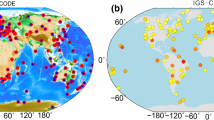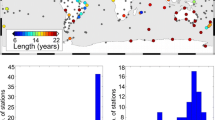Abstract
The tropospheric delay is an important error source in the Global Positioning System (GPS) positioning and navigation applications. Although most of the tropospheric delays can be removed in the double-differencing (DD) positioning mode, their remaining residuals can still contaminate the positioning accuracy and become unpredictable when tropospheric condition encounters severe variations such as during a tropical cyclone (TC) event. We investigated the positioning performance of five baselines with lengths ranging from 7.8 to 49.9 km during the 2017 TC Hato. The results showed that the TC Hato brought a significant disturbance to the GPS baseline positioning results, particularly in the vertical (up) component. The TC Hato started to affect Hong Kong and the root mean squares (RMS) of GPS positioning errors increased dramatically from about 30 to 140 mm, when it was at a distance of 400–600 km from Hong Kong on August 22, 2017. We found that the vertical positioning errors on that day have the major periods: 2.7 h, 3.0 h, 3.4 h, 4.0 h, and 4.8 h. Examining the wet and hydrostatic parts of the tropospheric delays via the continuous wavelet spectral analysis, we found that the periodical variation of the positioning results on August 22 was caused by the periodical variation of the precipitable water vapor (PWV). The variation of differenced PWV between two baseline stations had consistent periods of 2–5 h. Besides, the periods of differenced PWV time series are in good agreement with the spiral rainband in the TC. This finding suggests that the TC Hato induce periodical PWV variations at two GPS stations of baseline, which resulted in GPS positioning errors of the same periods.
















source: Hong Kong Observatory, obtainable from the Atmospheric and Environmental Database, hosted by the Environmental Central Facility, the Hong Kong University of Science and Technology, http://cozumel.ust.hk/dataview/hko_radar/current/)


Similar content being viewed by others
Data availability
The Lands Department of the Government (https://www.geodetic.gov.hk/en/rinex/downv.aspx) of Hong Kong Special Administrative Region (HKSAR) provided the GPS data from the Hong Kong Satellite Positioning Reference Station Network (SatRef). The Hong Kong Observatory provided the image of radar echoes (http://cozumel.ust.hk/dataview/hko_radar/current/). The International GNSS Service (IGS) provided the daily precise orbit and clock GPS products from the ftp address ftp://cddis.gsfc.nasa.gov/gps/products/ during the period of August 16–26, 2017. The National Oceanic and Atmospheric Administration (NOAA) provided the International Best Track Archive for Climate Stewardship (IBTrACS) data on tropical cyclones (https://www.ncei.noaa.gov/data/international-best-track-archive-for-climate-stewardship-ibtracs/v04r00/access/csv/). In addition, we also would like to thank the Japan Aerospace Exploration Agency (JAXA) (https://www.eorc.jaxa.jp/ptree/userguide.html) for providing the Himawari-8 L1 gridded data. The European Centre for Medium-Range Weather Forecasts (ECMWF) provided the data set of ECMWF atmospheric reanalysis of the global climate (ERA-Interim), which is available on the website https://apps.ecmwf.int/datasets/data/interim-full-daily/levtype=sfc/. The data used in this study have been uploaded to the public domain repository Figshare, which is a free data repository open to the public. The daily GPS data in the format of Receiver Independent Exchange Format (RINEX) 2.11 during the period from August 16–26, 2017 can be download from https://doi.org/10.6084/m9.figshare.12799943.v1. The precise daily orbit (sp3) and clock (clk_30s) GPS products are available from https://doi.org/10.6084/m9.figshare.12799949.v1. The records of the tropical cyclone Hato (1713) are available at https://doi.org/10.6084/m9.figshare.12781820.v1. The Himawari-8 image at 04:00 UT on August 22, 2017 can be downloaded from https://doi.org/10.6084/m9.figshare.12799931.v1. The water vapor pressure and temperature of ERA-Interim hourly data on pressure levels ranging from 21 to 26 N and 112 E to 123 E in latitude and longitude in August 2017 can be found at https://doi.org/10.6084/m9.figshare.12799964.v1.
References
Atkinson GD (1971) Forecaster’s guide to tropical meteorology. United States Air Force, Air Weather Service
Calori A, Santos JR, Blanco M, Pessano H, Llamedo P, Alexander P, de la Torre A (2016) Ground-based GNSS network and integrated water vapor mapping during the development of severe storms at the Cuyo region (Argentina). Atmospheric Res 176–177:267–275. https://doi.org/10.1016/j.atmosres.2016.03.002
Chen B, Liu Z (2016) A comprehensive evaluation and analysis of the performance of multiple tropospheric models in China region. IEEE Trans Geosci Remote Sens 54(2):663–678. https://doi.org/10.1109/TGRS.2015.2456099
Chen B, Liu Z, Wong W-K, Woo W-C (2017) Detecting water vapor variability during heavy precipitation events in Hong Kong using the GPS tomographic technique. J Atmospheric Ocean Technol 34(5):1001–1019. https://doi.org/10.1175/jtech-d-16-0115.1
Chen D, Ye S, Xu C, Jiang W, Jiang P, Chen H (2019) Undifferenced zenith tropospheric modeling and its application in fast ambiguity recovery for long-range network RTK reference stations. GPS Solut 23(1):26. https://doi.org/10.1007/s10291-018-0815-x
Dach R, Lutz S, Walser P, Fridez P (2015) Bernese GNSS Software version 5.2. User manual, Astronomical Institute, University of Bern, Bern Open Publishing
Hobiger T, Shimada S, Shimizu S, Ichikawa R, Koyama Y, Kondo T (2010) Improving GPS positioning estimates during extreme weather situations by the help of fine-mesh numerical weather models. J Atmospheric Sol-Terr Phys 72(2):262–270. https://doi.org/10.1016/j.jastp.2009.11.018
Hong Kong Observatory (2019) Tropical cyclones in 2017. Hong Kong Observatory, Hong Kong
Huang L, Jiang JH, Wang Z, Su H, Deng M, Massie S (2015) Climatology of cloud water content associated with different cloud types observed by A-Train satellites. J Geophys Res Atmospheres 120(9):4196–4212. https://doi.org/10.1002/2014JD022779
Knapp KR, Kruk MC, Levinson DH, Diamond HJ, Neumann CJ (2010) The international best track archive for climate stewardship (IBTrACS). Bull Am Meteorol Soc 91(3):363–376. https://doi.org/10.1175/2009BAMS2755.1
Lee Y-K, Li J, Li Z, Schmit T (2017) Atmospheric temporal variations in the pre-landfall environment of typhoon Nangka (2015) observed by the Himawari-8 AHI. Asia-Pac J Atmospheric Sci 53(4):431–443. https://doi.org/10.1007/s13143-017-0046-z
Li B, Feng Y, Shen Y, Wang C (2010) Geometry-specified troposphere decorrelation for subcentimeter real-time kinematic solutions over long baselines. J Geophys Res Solid Earth. https://doi.org/10.1029/2010JB007549
Liu Y, San Liang X, Weisberg RH (2007) Rectification of the Bias in the wavelet power spectrum. J Atmospheric Ocean Technol 24(12):2093–2102. https://doi.org/10.1175/2007JTECHO511.1
Marks FD (2015) Tropical Cyclones And Hurricanes | Hurricanes: Observation. In: North GR, Pyle J, Zhang F (eds) Encyclopedia of atmospheric sciences, 2nd edn. Academic Press, Oxford, pp 35–56
Saastamoinen J (1972) Atmospheric correction for the troposphere and stratosphere in radio ranging satellites. Use Artif Satell Geod. https://doi.org/10.1029/GM015p0247
Santerre R, Geiger A (2018) Geometry of GPS relative positioning. GPS Solut 22(2):50–50. https://doi.org/10.1007/s10291-018-0713-2
Selbesoglu MO (2020) Prediction of tropospheric wet delay by an artificial neural network model based on meteorological and GNSS data. Eng Sci Technol Int J 23(5):967–972. https://doi.org/10.1016/j.jestch.2019.11.006
Strang G (1994) Wavelets. Am Sci 82(3):250–255
Tang W, Shen M, Deng C, Cui J, Yang J (2018) Network-based triple-frequency carrier phase ambiguity resolution between reference stations using BDS data for long baselines. GPS Solut 22(3):73. https://doi.org/10.1007/s10291-018-0737-7
Torrence C, Compo GP (1998) A practical guide to wavelet analysis. Bull Am Meteorol Soc 79(1):61–78. https://doi.org/10.1175/1520-0477(1998)079%3c0061:APGTWA%3e2.0.CO;2
Tunalı E, Özlüdemir MT (2019) GNSS PPP with different troposphere models during severe weather conditions. GPS Solut 23(3):82. https://doi.org/10.1007/s10291-019-0874-7
Virts KS, Houze RA (2015) Clouds and water vapor in the tropical tropopause transition layer over mesoscale convective systems. J Atmospheric Sci 72(12):4739–4753. https://doi.org/10.1175/JAS-D-15-0122.1
Wielgosz P, Paziewski J, Baryła R (2011). On constraining zenith tropospheric delays in processing of local GPS Networks with Bernese Software. Surv Rev. 43(323): 472–483 https://doi.org/10.1179/003962611X13117748891877
Wilgan K, Geiger A (2018) High-resolution models of tropospheric delays and refractivity based on GNSS and numerical weather prediction data for alpine regions in Switzerland. J Geod 93(6):819–835. https://doi.org/10.1007/s00190-018-1203-6
Wilgan K, Hadas T, Hordyniec P, Bosy J (2017) Real-time precise point positioning augmented with high-resolution numerical weather prediction model. GPS Solut 21(3):1341–1353. https://doi.org/10.1007/s10291-017-0617-6
Xu H, Li X (2017) Torrential rainfall processes associated with a landfall of Typhoon Fitow (2013): a three-dimensional WRF modeling study. J Geophys Res Atmospheres 122(11):6004–6024. https://doi.org/10.1002/2016JD026395
Yeh T-K, Hong J-S, Wang C-S, Chen C-H, Chen K-H, Fong C-T (2016) Determining the precipitable water vapor with ground-based GPS and comparing its yearly variation to rainfall over Taiwan. Adv Space Res 57(12):2496–2507. https://doi.org/10.1016/j.asr.2016.04.002
Zhang D, Zhang J, Yao F, Shi L (2019) Observed characteristics change of tropical cyclones during rapid intensification over Western North Pacific using cloudsat data. IEEE J Sel Top Appl Earth Obs Remote Sens 12(6):1725–1733. https://doi.org/10.1109/JSTARS.2019.2917091
Zhang Q, Li F, Zhang S, Li W (2020) Modeling and forecasting the GPS zenith troposphere delay in West Antarctica based on different blind source separation methods and deep learning. Sensors. https://doi.org/10.3390/s20082343
Zheng F, Lou Y, Gu S, Gong X, Shi C (2018) Modeling tropospheric wet delays with national GNSS reference network in China for BeiDou precise point positioning. J Geod 92(5):545–560. https://doi.org/10.1007/s00190-017-1080-4
Acknowledgment
The grant support from the Key Program of the National Natural Science Foundation of China (project No.: 41730109) is acknowledged. The grant supports from the Hong Kong Research Grants Council (RGC) projects (B-Q61L PolyU 152222/17E) are highly appreciated. The support from the project (No. 1-BBWJ) in the Emerging Frontier Area (EFA) Scheme of the Research Institute for Sustainable Urban Development (RISUD) of The Hong Kong Polytechnic University is also acknowledged.
Author information
Authors and Affiliations
Corresponding author
Additional information
Publisher's Note
Springer Nature remains neutral with regard to jurisdictional claims in published maps and institutional affiliations.
Rights and permissions
About this article
Cite this article
Yu, S., Liu, Z. Tropical cyclone-induced periodical positioning disturbances during the 2017 Hato in the Hong Kong region. GPS Solut 25, 109 (2021). https://doi.org/10.1007/s10291-021-01112-3
Received:
Accepted:
Published:
DOI: https://doi.org/10.1007/s10291-021-01112-3




